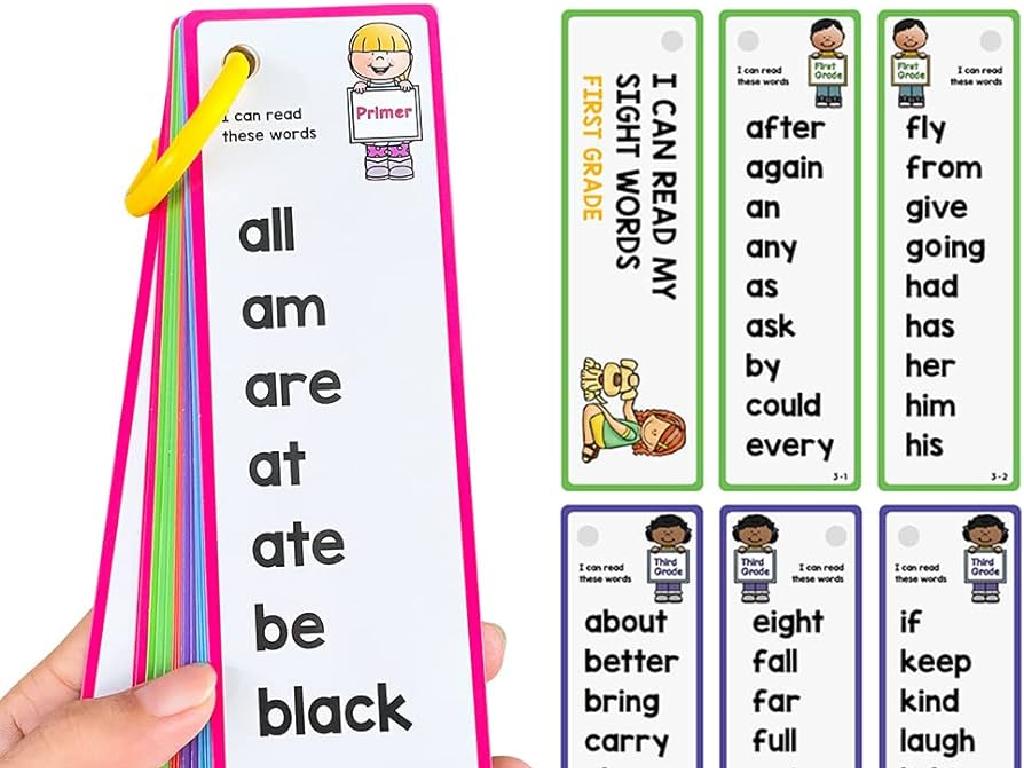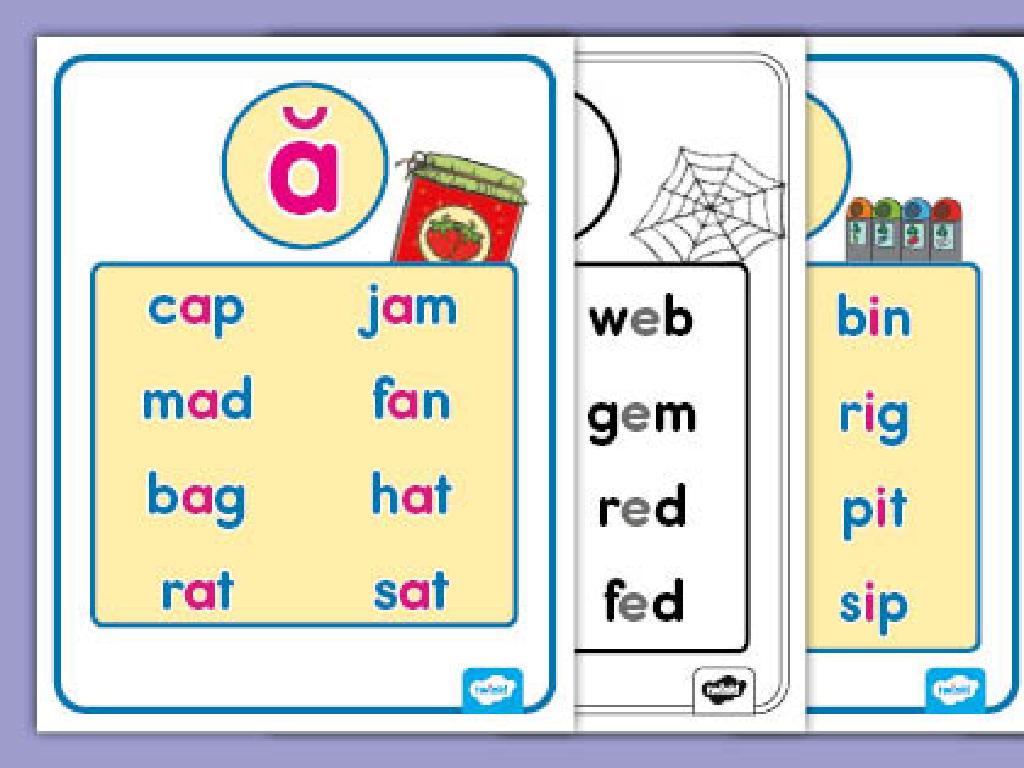Identify Halves
Subject: Math
Grade: Kindergarten
Topic: Fractions Of Shapes
Summary: Introduce Kindergarten students to the concept of halves in this engaging math lesson on fractions of shapes. Children will learn to identify halves using real-life examples like pizza, apples, and sandwiches, and practice dividing objects and shapes into two equal parts. Interactive activities with coloring and playdough help reinforce the idea of fairness and equality. By exploring shapes in everyday life, students gain foundational skills in recognizing and creating halves, supporting early math success.
Please LOG IN to download the presentation. Access is available to registered users only.
View More Content
Welcome to Fractions!
– Greetings Kindergarten Superstars!
– Today’s math adventure: fractions
– Fractions are like pieces of a whole
– Imagine breaking a cookie into two equal parts
– Let’s say ‘fractions’ together!
|
This slide is designed to introduce Kindergarten students to the concept of fractions in a fun and engaging way. Start by greeting the students enthusiastically to capture their attention. Explain that today’s lesson is about fractions, a new math idea. Use simple language to describe fractions as parts of a whole, like pieces of a cookie or a pizza that are shared equally. Encourage the students to repeat the word ‘fractions’ after you to help them remember it. Use hand gestures to show breaking something into parts as you explain. The goal is to create a friendly and interactive atmosphere that makes learning about fractions exciting.
Learning About Halves
– Fractions are parts of a whole
– A whole pizza is yummy
– Sharing pizza makes halves
– When you cut something into two equal pieces, each piece is a half
– Each half is one of two equal parts
– Imagine splitting a cookie evenly with a friend
|
This slide introduces the concept of fractions, specifically focusing on halves, in a way that is relatable to Kindergarten students. Begin by explaining that a fraction represents a part of something that is whole. Use the example of a pizza, which is something familiar and appealing to children, to illustrate the concept of a whole. Then, show how sharing the pizza with a friend by cutting it into two equal parts creates halves. Each half is one of two equal parts of the whole pizza. Encourage the students to think of other examples of halves, such as cutting an apple or a sandwich in two. Use visual aids like pictures or actual objects to help them understand. The goal is to make the concept of halves tangible and understandable through everyday examples.
Meet the Halves: Equal Parts
– Cutting things into two equal parts
– Each equal part is called a half
– Examples of things cut into halves
– Like a sandwich, apple, or a piece of paper
– Both halves are equal in size
|
This slide introduces the concept of halves to Kindergarten students. Begin by explaining that when something is cut into two equal parts, each part is called a half. Use tangible examples like cutting a sandwich, an apple, or a piece of paper to illustrate the idea. Emphasize that for something to be in halves, both parts must be the same size. You can use visual aids or actual objects to demonstrate this concept. Encourage the students to think of other items that can be cut into halves and discuss why each part is called a half. This will help them understand the concept of equal parts, which is fundamental in learning about fractions.
Identifying Halves
– What are halves?
– Halves are two equal parts
– When something is split into 2 parts, both should be the same
– Practice with shapes
– Look at different shapes cut into halves. Are the parts equal?
– Both parts must match
– Check if one part is the same size as the other
|
This slide introduces the concept of halves to Kindergarten students. Begin by explaining that when something is cut into halves, it is split into two equal parts. Use visual aids like shapes (circles, squares, rectangles) that are clearly divided into halves to illustrate this point. Encourage the students to observe whether the two parts of the shapes are of the same size, which is crucial for understanding halves. During the practice, ask the students to identify if the shapes presented are cut into equal halves and explain why or why not. This activity will help them visually grasp the concept of equal parts and apply it to different shapes.
Halves in Everyday Life
– Halves are all around us
– Things that can be in halves
– Think of items that can be split into 2 equal parts
– Examples: apple, sandwich
– An apple cut into two equal pieces, or a sandwich divided down the middle
– Understanding halves is fun
|
This slide introduces the concept of halves in a way that is relatable to Kindergarten students by connecting it to everyday objects. Begin by explaining that a half means one of two equal parts of a whole. Encourage the children to think of items they encounter daily that can be divided into halves. Use tangible examples like cutting an apple or a sandwich into two equal pieces to illustrate the idea of halves. This will help them visualize and understand the concept of halves in a practical context. During the presentation, you can bring in an apple or a sandwich and demonstrate cutting it into halves to make the learning experience interactive and engaging.
Let’s Practice Together: Finding Halves!
– It’s your turn to find halves
– Color one half of each shape
– Use your favorite colors to fill one side
– Both halves must be equal
– Imagine splitting the shape down the middle
– Show your colored shapes in class
|
This activity slide is designed to help Kindergarten students understand the concept of halves by coloring shapes. Provide them with shapes that are clearly divided in the middle so they can easily see the two halves. Encourage them to choose a color and fill in one side of the shape completely. Remind them that both sides of the shape should be the same size to represent halves. After the coloring activity, ask the students to present their work to the class, which will reinforce their understanding and give them a chance to demonstrate their knowledge. Prepare additional shapes in case some students finish early and want more practice.
Class Activity: Making Halves with Playdough!
– Roll playdough into balls
– Cut the balls into halves
– Both halves must be equal
– Equal halves mean both parts are the same size
– Why equal halves matter
– Understanding fairness and equality in sharing
|
This hands-on activity is designed to help Kindergarten students understand the concept of halves by using playdough. Start by demonstrating how to roll playdough into a ball. Then, show them how to use a plastic knife or string to cut the ball into two equal parts, emphasizing the importance of making both halves the same size. Explain that when we cut something into halves, we are dividing it into two equal parts, which is a fair way to share. Encourage the children to compare their halves with each other to see if they are equal. This activity not only teaches fractions but also the concept of equality and fairness. Possible variations of the activity could include cutting different shapes into halves or even combining two different colored halves to make a whole.
Review and Goodbye: Learning About Halves
– Recap: What are halves?
– Halves are two equal parts of a whole
– Identify halves around us
– Find an object, show one half
– Praise for today’s work
– Looking forward to next time
|
As we conclude today’s lesson on halves, we’ll revisit the key points to ensure understanding. Start by asking the students to define halves in their own words, reinforcing the concept that a half is one of two equal parts of a whole. Encourage them to look around the classroom or think of examples at home where they can visually identify halves, such as a cut apple or a sandwich divided into two equal parts. Offer praise to acknowledge their hard work and participation throughout the lesson. Let them know you’re excited to see them in the next class and continue exploring math together. This positive reinforcement helps build their confidence and enthusiasm for learning.





